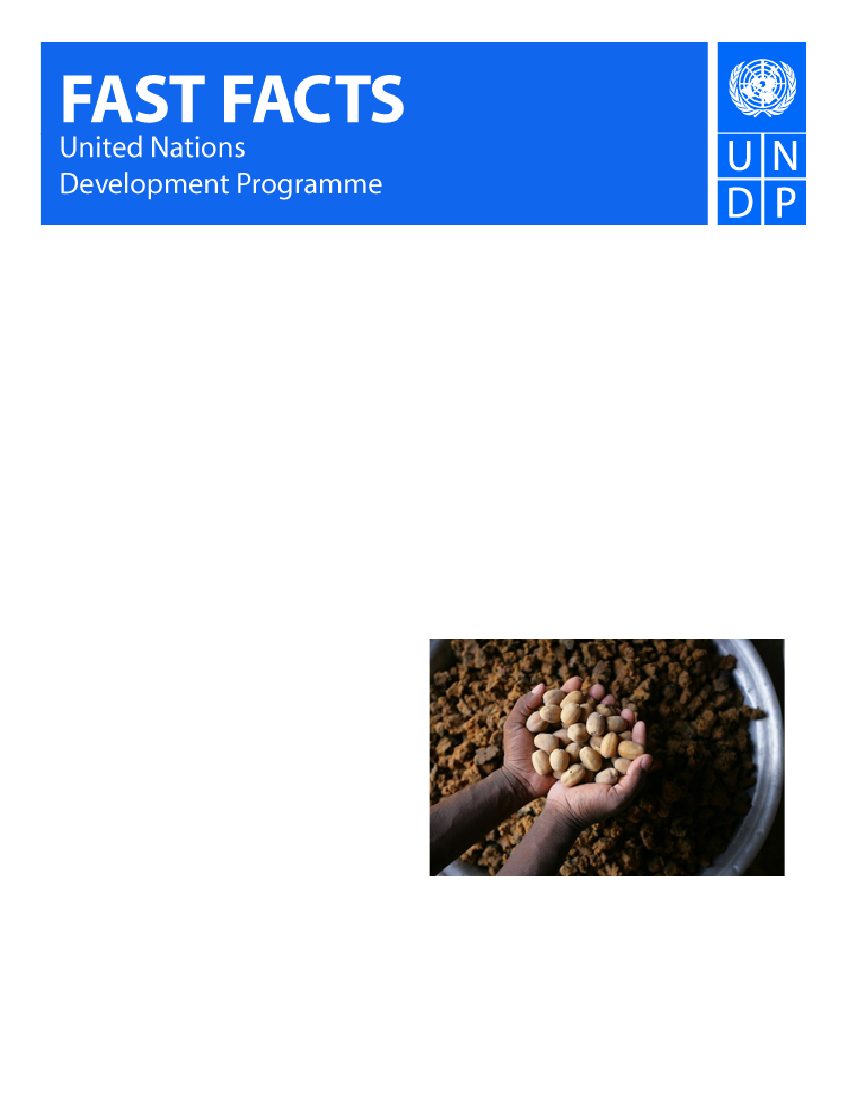Udenrigsudvalget 2009-10
URU Alm.del Bilag 240
Offentligt
The Millennium Development GoalsIn September 2000, 189 world leaders met at the UN andendorsed the Millennium Declaration, a commitment to worktogether to build a safer, more prosperous and equitable world.The Declaration was translated into a roadmap setting out eighttime-bound and measurable goals to be reached by 2015,known as the Millennium Development Goals (MDGs):Goal 1 Eradicate extreme poverty and hunger••Reduce by half the proportion of people whose incomeis less than $1 a dayReduce by half the proportion of people who sufferfrom hunger
••
•
Deal with developing countries’ debtIn cooperation with developing countries, develop andimplement strategies for decent and productive workfor youthIn cooperation with the private sector, make availablethe benefits of new technologies, especiallyinformation and communications
ProgressA decade after the Millennium Declaration, we can point toundeniable progress on some MDGs in many countries. Therehave been noticeable reductions in poverty globally. Significantimprovements have been made in enrolment and gender parityin schools. Progress is evident in reducing child and maternalmortality, increasing HIV treatments and ensuringenvironmental sustainability. Developing countries areincreasingly incorporating the MDGs into their nationaldevelopment strategies, reforming policies and buildinginstitutions in order to effectively implement those plans. Therehave been welcome developments in the global partnership,where, although still not complete, some countries have mettheir commitments.
Goal 2 Achieve universal primary education•Ensure that all boys and girls complete a full course ofprimary schooling
Goal 3 Promote gender equality and empower women•Eliminate gender disparity in primary and secondaryeducation preferably by 2005, and in all levels ofeducation no later than 2015
Goal 4 Reduce child mortality•Reduce by two thirds the mortality of children under-five
Goal 5 Improve maternal health•Reduce maternal mortality by three quarters
Goal 6 Combat HIV and AIDS, malaria and other diseases••Halt and reverse the spread of HIV and AIDSHalt and reverse the incidence of malaria and othermajor diseases
Goal 7 Ensure environmental sustainability•Integrate principles of sustainable development intocountry policies and programmes; reverse the loss ofenvironmental resourcesHalve the proportion of people without access to safedrinking water and basic sanitationImprove the lives of at least 100 million slum dwellersby 2020
••
Photo by UNDP Burkina Faso
ChallengesWhile the share of poor people is declining, the absolutenumber of the poor in South Asia and in sub-Saharan Africa isincreasing. Countries that achieved rapid reductions in incomepoverty are not necessarily making the same progress in genderequality and environmental sustainability. Lack of progress inreducing HIV is curtailing improvements in both maternal andchild mortality. Moreover, we have not paid enough attention to
Goal 8 Develop a global partnership for development••Develop further an open, rule-based, predictable, non-discriminatory trading and financial systemAddress special needs of the least developed countries,landlocked countries and Small Island DevelopingStates
the quality of education and health services in the rush toexpand coverage. In sub-Saharan Africa, no country is currentlyon course to achieve all the MDGs by 2015.MDG progress is also threatened by the combination of highfood prices and the impact of the international financial andeconomic crisis. Sustained poverty and hunger reduction is atrisk because of vulnerability to climate change, particularly inthe area of agricultural production. Weak institutional capacityin conflict and post-conflict countries slows MDG progress. Andrapid urbanisation is putting pressure on social services.1.2 billion people across the world are hungry. Sevenout of 10 of them are women and girlsMillions of children start school but eventually dropout — too many of them leave school without havingacquired the most basic literacy and numeracy skillsWomen hold 18 percent of seats in parliamentEvery year, 536,000 women and girls die as a result ofcomplications during pregnancy, childbirth or the sixweeks following delivery. 99 percent of them occur indeveloping countriesTwo thirds of those living with HIV are in sub-SaharanAfrica. Most of them are women1.2 billion people lack access to basic sanitation. Thevast majority of them live in rural areasAid to the poorest countries falls far short of the 2010target
•Afghanistan’sBasic Package of Health Services focused onconstruction of health centres and hospitals, training of healthworkers, and large-scale vaccinations. Amidst conflicts, under-five mortality declined significantly between 2002 and 2004.•Cambodia’s100 percent Condom Use Programmecontributed to twice as much condom use among sexworkers. HIV prevalence declined from 1.2 to 0.7 percentbetween 2003 and 2008.•Panama’sconditional cash transfer programme provided freeprimary care services, vaccinations and reproductivehealthcare to 70,599 households, or 95 percent of peopleliving under the poverty line, during 2007 – 2008.•South Asia’sWomen Well-being, Work, Waste and Sanitationproject trained women as sanitation facilities installers. It alsoallowed them to earn additional income.•Ethiopiapromoted small- and medium-scale enterprises,community-based urban works programmes and constructedover 80,000 public housing units to address the 60 percentrise in slum dwellers between 1990 and 2008.•Small-scale micro projects such as provision of low-costelectricity in the form of bio-fuel multi-functional platforms inBurkina Faso, Ghana, MaliandSenegalhave createdincome-generating opportunities for women, while reducingtime poverty by up to six hours a day.
A Global Action PlanThe most important lesson learnt is that the MDGs can beachieved even in the poorest and most disadvantagedcountries. Today, the world has the knowledge and resources toaccelerate progress. What is required is increased commitmentto see through the strategies, policies and interventions. In itsinternational assessment (InternationalAssessment Report)ofwhat it will take to achieve the MDGs, UNDP proposes thefollowing action agenda:1.Support country-led development2. Foster inclusive economic growth3. Increase public investments in education,health, water and sanitation and infrastructure4. Scale up targeted interventions, includingsocial protection and employmentprogrammes5. Invest in women and girls6. Enhance access to alternative energy andpromote low-carbon development7. Accelerate domestic resource mobilisation tofinance the MDGs8. Deliver on Official Development Aidcommitments, and improve its predictability,effectiveness, division of labour anddisbursement modalityFor more information, visit:www.undp.orgwww.undp.org/mdgUnited Nations Development ProgrammeOne United Nations PlazaNew York, NY 10017, USA+1-212-906-5000June 2010
Country-Level EvidenceThere are important synergies among the MDGs — accelerationin one Goal often speeds up progress in others. For instance,gender equality and women’s empowerment have largemultiplier impacts on other MDGs. Evidence shows thatacceleration of progress is possible when strong governmentleadership, effective policies and institutional capacity forscaling up public investments are complemented by adequatefinancial and technical support from the internationalcommunity. Recent examples include:•Malawi’snational fertiliser subsidy programme has beenassociated with an increased total cultivation area by 25percent. Maize production reached 3.2 million tonnes in 2007,ensuring self-sufficiency.•Debt relief throughNigeria’sVirtual Poverty Fund wasdirected to agriculture and contributed to doublingagricultural production and farmers’ income.•Abolition of school fees at the primary level contributed tosurges of enrolment inEthiopia, Ghana, Kenya,Mozambique, NepalandTanzania.•InBahrain,98 percent of women participated in areferendum in 2001, paving the way for legislative reformsthat gave Bahraini women full rights as citizens.


